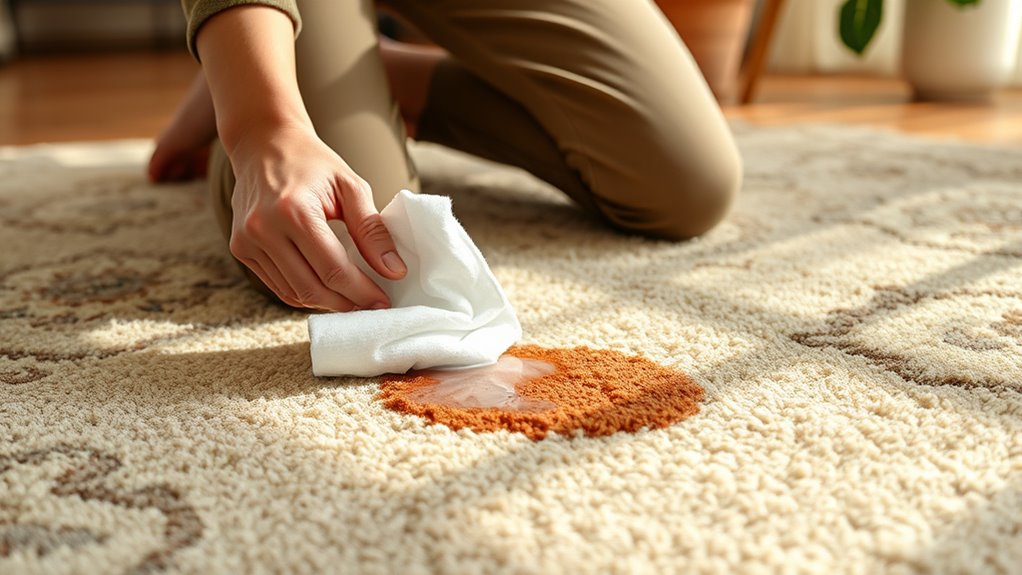To spot-clean carpets without a machine, act fast by blotting fresh stains with absorbent materials like towels or paper towels, working from outside inward. Apply a mild cleaning solution such as vinegar-water or dish soap diluted properly, testing on hidden areas first. Gently scrub with damp cloths or sponges, then rinse and blot to remove residue. Use fans or dehumidifiers for quick drying. Keep practicing these simple steps to keep your carpet looking its best.
Key Takeaways
- Blot fresh stains immediately with a dry cloth or paper towels, working from outside inward to prevent spreading.
- Use homemade solutions like vinegar-water spray or dish soap diluted in water for targeted spot cleaning.
- Test cleaning agents on hidden areas first to avoid discoloration or damage before applying to visible stains.
- Apply cleaning solutions with a spray or dabbing method, then gently blot or lift with absorbent cloths without rubbing.
- Ensure thorough drying with towels, fans, or open windows to prevent mold and restore carpet appearance.
Blotting Fresh Stains With Absorbent Materials
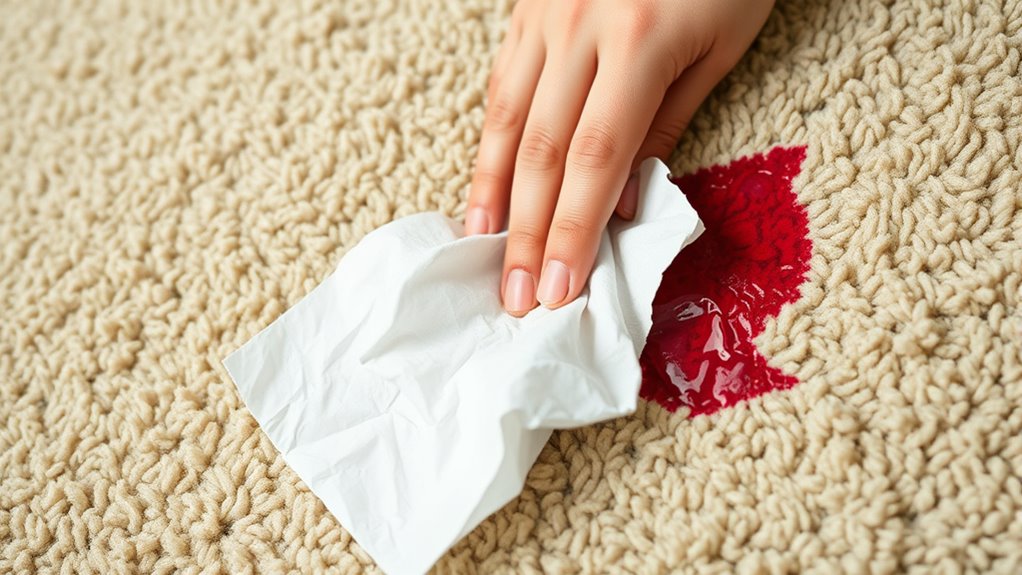
When you notice a fresh stain on your carpet, it’s essential to act quickly. Start by blotting the stain with a clean, dry cloth or paper towels to prevent the liquids from setting. Use gentle pressing rather than rubbing, which helps absorb the moisture without spreading the stain further. Place multiple layers of absorbent material over the spill and apply light pressure to draw out as much liquid as possible. Keep changing or reusing the absorbent material until no more moisture transfers from the stain. Always work from the outside of the stain inward to contain it and prevent it from enlarging. Acting promptly with blotting and absorbent materials helps keep the stain manageable and makes cleaning easier later. Incorporating proper work environment strategies can also reduce stress and improve your overall approach to quick cleaning tasks. Additionally, ensuring your home heating solutions operate quietly can help maintain a calm atmosphere while you clean. Proper understanding of carpet fibers can further enhance your spot-cleaning effectiveness.
Applying Mild Cleaning Solutions for Stubborn Spots
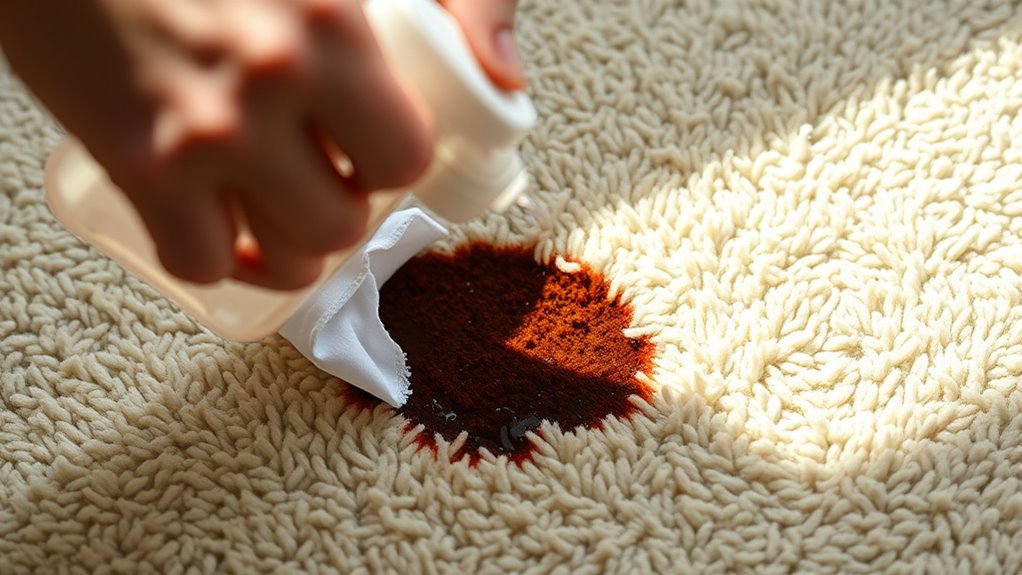
Start by selecting an effective cleaning agent, like a vinegar and dish soap mixture, suited for stubborn stains. Always test the solution on a small, inconspicuous area first to prevent damage. When applying, spray generously and let it sit for a few minutes before blotting gently to lift the stain. Incorporating natural antioxidants found in some fruit juices can also be an eco-friendly alternative for cleaning or freshening up carpet spots. Additionally, understanding exfoliation benefits can help in choosing gentle yet effective solutions for delicate carpet fibers. Being aware of water-based cleaning techniques can further enhance your ability to effectively remove spots without a machine. Moreover, considering contrast ratio and lighting conditions can influence how well cleaned spots appear once the carpet is dry. Staying informed about AI processing power can assist in selecting the most effective cleaning methods for different carpet types.
Choosing Effective Cleaning Agents
Choosing the right cleaning agent is essential for effectively tackling stubborn carpet stains without causing damage. For spot cleaning, select gentle, natural cleaning solutions like white vinegar mixed with water (1/4 cup vinegar to 1 cup water). You can also use diluted soap or household solutions to loosen grime. For greasy spots, sprinkle baking soda to absorb residue before blotting. Always test your chosen cleaning agent on a hidden area first to prevent discoloration or fiber damage. Here are some effective options:
- White vinegar and water mixture
- Diluted dish soap
- Homemade cleaners with natural cleaning properties
- Baking soda for oily stains
- Light disinfectants for enhanced stain removal
Using these cleaning agents helps remove stubborn stains safely while preserving your carpet’s fibers. Proper cleaning techniques ensure the best results and prevent fiber damage. Additionally, understanding the fiber type of your carpet can guide you in selecting the most suitable cleaning agents for optimal care. Incorporating appropriate cleaning methods can further improve stain removal effectiveness and prolong your carpet’s lifespan.
Testing on Small Areas
Before treating visible stains, it’s essential to test your cleaning solution on a small, hidden area of the carpet. This patch test helps check for colorfastness and guarantees the cleaning solution won’t damage or discolor the carpet fibers. Use a small amount of the solution on a clean cloth or sponge and gently dab the test spot. Observe for any changes, such as discoloration or texture issues, over 10-15 minutes. Avoid excessive solution, as too much can affect the adhesive or cause unwanted damage. Record the results to determine if the solution is safe for stain removal. Performing this small area test reduces the risk of widespread discoloration and guarantees that your cleaning method is safe before tackling the visible stain. Additionally, environmental considerations suggest using eco-friendly solutions to minimize ecological impact during cleaning, as eco-conscious practices support overall sustainable cleaning efforts. It’s also beneficial to consult professional cleaning techniques if you’re uncertain about the best approach for your specific carpet type.
Application and Blotting Techniques
When treating stubborn carpet stains, applying a mild cleaning solution carefully is key to avoiding damage. Start by lightly spraying or dabbing a small amount of the cleaning solution, like a vinegar-water mix, onto the stain. Use an absorbent cloth or paper towel to gently blot the area, pressing down to lift the stain without rubbing. Always work from the outside edges inward to prevent spreading. Be careful not to oversaturate the carpet, which can cause mold or damage. Proper moisture levels are essential for effective spot cleaning and to prevent mold growth. Additionally, understanding the resources and tools available can help you select the best cleaning solutions for your needs. For example, using the right cleaning technique can significantly improve stain removal efficiency. Choosing the appropriate filtering methods can also protect your carpet fibers from damage during cleaning. Using a proper drying method afterward ensures the area dries quickly and thoroughly, preventing mold. Remember these tips:
- Apply solution sparingly to avoid oversaturating
- Work from outside to inside to prevent spreading
- Use blotting instead of rubbing for stain removal
- Press down gently to lift the stain
- Repeat until the stain is gone
Gently Scrubbing With Damp Cloths or Sponges
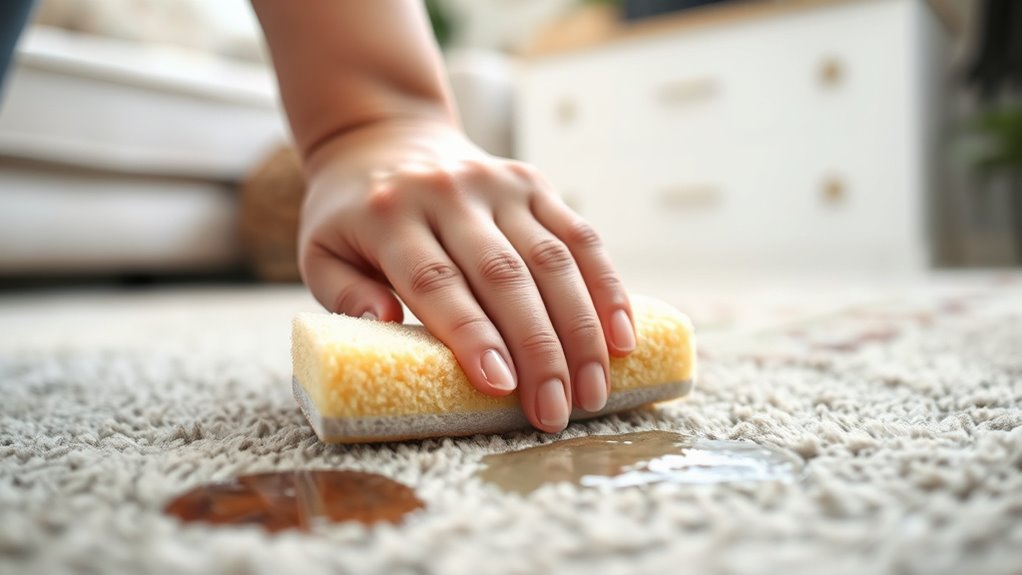
To effectively spot-clean carpets without a machine, start by dampening a clean microfiber cloth or sponge with water and a small amount of mild detergent or vinegar solution. Use the damp cloth to gently scrub stained or soiled areas with circular motions, lifting dirt without damaging fibers. Be careful not to oversaturate the cloth or sponge, preventing excess moisture from seeping into the carpet backing. During cleaning, rinse the microfiber cloth frequently in clean water to remove dirt and residues. Here’s a quick guide:
| Step | Tips | Result |
|---|---|---|
| Dampening cloth | Use a microfiber cloth or sponge | Gentle cleaning |
| Spot cleaning | Focus on stains with circular motions | Effective stain removal |
| Rinsing | Rinse cloth often in clean water | Keeps dirt at bay |
| Gentle scrubbing | Use light pressure | Protects fibers |
| Blotting & drying | Remove excess moisture | Faster drying |
Additionally, it’s important to understand that fiber protection can be maintained through gentle cleaning methods like these to prevent damage over time. Proper technique ensures that carpets retain their appearance and durability over the long term, especially when combined with regular maintenance. Incorporating appropriate cleaning solutions can enhance stain removal effectiveness without harming carpet fibers.
Rinsing and Blotting to Remove Residue

After gently scrubbing stained areas with damp cloths or sponges, the next step is to rinse and blot to remove any remaining residue. Rinsing with clean water guarantees that leftover cleaning agents or stain materials don’t attract dirt later. Use a damp cloth or microfiber cloth to gently rinse the area, avoiding over-wetting that could lead to mold. Then, blot the area firmly to absorb excess moisture and loosened dirt without spreading the stain. Remember, repeating this process helps achieve thorough removal of residue. To maximize stain removal:
- Blot with a dry microfiber cloth
- Rinse with clean water
- Use gentle, pressing motions
- Focus on removing all cleaning agents
- Avoid rubbing, which can damage fibers
This careful rinsing and blotting process ensures your carpet stays clean and free of sticky residues.
Using Household Items for Spot Cleaning (Vinegar, Baking Soda, Etc.)
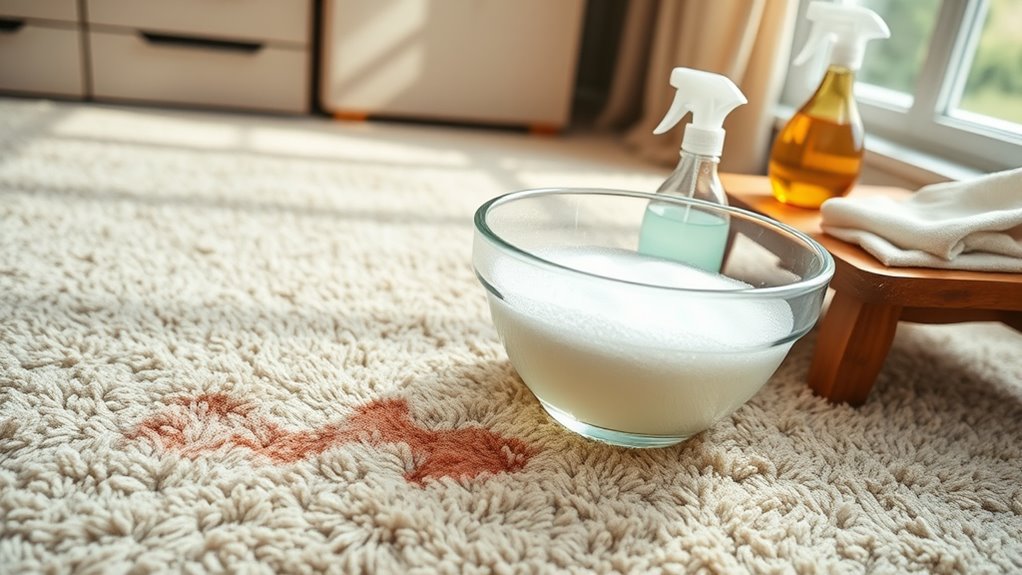
Household items like vinegar, baking soda, and dish soap can be effective tools for spot cleaning carpets without a machine. Using DIY cleaning, you can create natural cleaners for stain removal and freshen your carpets. Mix equal parts vinegar and water in a spray bottle to target fresh carpet spots, then blot with a clean cloth to absorb excess moisture. For odors or stubborn stains, sprinkle baking soda directly onto the affected area, letting it sit to absorb moisture and scents before vacuuming. A small amount of dish soap diluted in water helps lift greasy or organic stains. Always test homemade solutions on a hidden area to prevent discoloration. These cleaning tips make stain removal simple and affordable using everyday household items.
Testing Cleaning Products on Small Hidden Areas

Before applying any cleaning product, test it on a small, hidden area of your carpet to check for colorfastness. Use a cotton swab or cloth with a diluted solution, and wait 10-15 minutes to see if any discoloration occurs. Take photos before and after to compare, and stop using the product immediately if you notice fading or damage.
Small Area Testing
Have you ever wondered how to guarantee a cleaning product won’t damage your carpet? Performing a small-area test is essential before full stain removal. By testing cleaning solutions on an inconspicuous area—such as behind furniture—you can check for colorfastness and fiber damage. Here’s what to do:
- Apply a small amount of cleaning products on a hidden spot
- Wait 10-15 minutes to observe for discoloration or damage
- Gently blot with a clean cloth or sponge
- Inspect for fading, staining, or fiber damage
- Record your test results for future reference
This small-area testing helps prevent damage and ensures safe, effective stain removal. It’s a simple step that offers damage prevention and confidence in your cleaning efforts.
Colorfastness Verification
To guarantee your carpet cleaning products won’t cause discoloration or damage, start by verifying colorfastness through a small, hidden test area. Apply a small amount of the cleaning solution to a test patch behind furniture or along a corner. Wait 5-10 minutes to observe any fabric reaction, such as discoloration or dye transfer. Use a clean, white cloth or sponge to avoid spreading the stain or affecting fiber safety. If no color change occurs, it’s safe to proceed with stain removal on the visible area. However, if discoloration or dye transfer appears, discontinue use of that cleaning solution immediately. Testing on a small area helps ensure your cleaning method won’t damage or discolor your carpet, safeguarding its appearance and fiber integrity.
Treating Specific Stains (Wine, Coffee, Ink, Grease)

When dealing with specific stains like wine, coffee, ink, or grease, acting quickly can make all the difference. To prevent damage and discoloration, start by blotting the stain with a clean, dry cloth. For wine stains, use a mixture of equal parts white vinegar and water, then blot dry. Coffee stains respond well to a damp cloth soaked in dish soap and water, followed by rinsing. Ink stains are best treated with rubbing alcohol or a commercial ink remover applied carefully with a cotton swab, then blotted dry. Grease stains benefit from dish soap applied directly, left for 10-15 minutes, then blotted with a damp cloth. Always test cleaning solutions on a hidden spot to avoid discoloration and ensure effective spot treatment.
Managing Excess Moisture and Drying Techniques
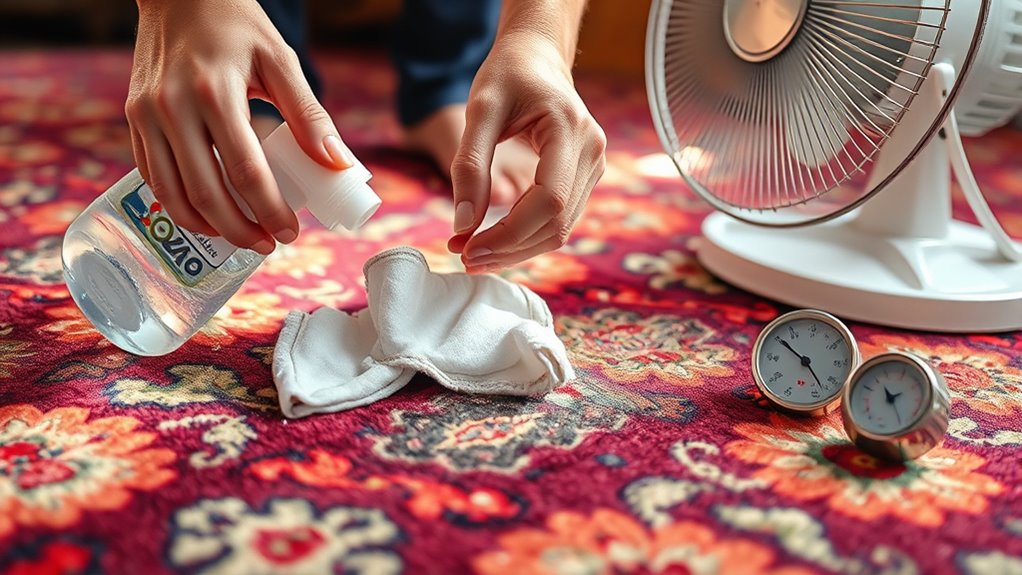
Effective moisture management is essential for preventing mold and preserving your carpet’s integrity after cleaning. Use proper drying techniques to remove excess moisture efficiently. Blot the damp area with dry towels or microfiber cloths to lift moisture without damaging fibers. To speed up the drying process, set up fans or use dehumidifiers and open windows to improve air circulation. Absorbent materials, like towels or mats, can help draw out additional moisture during the drying process. Ensure all areas, including the backing and padding, are fully dry before walking on or placing furniture back, preventing trapped moisture. Proper moisture removal minimizes the risk of mold and mildew growth, keeping your carpet fresh and in good condition over time.
Maintaining Regular Spot Cleaning Habits
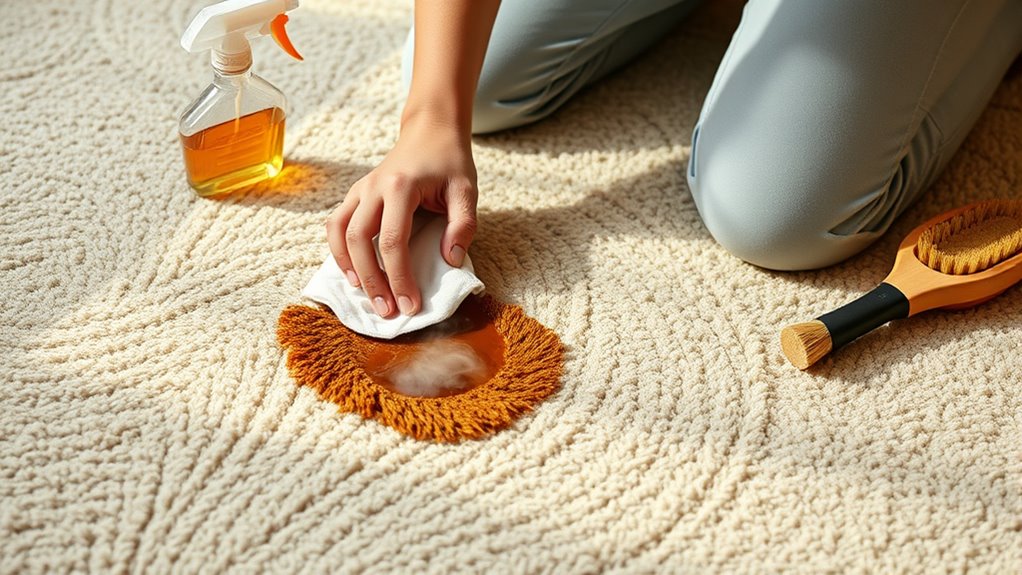
Maintaining regular spot cleaning habits is key to keeping your carpet looking its best. By acting quickly, you prevent stains from setting and protect your carpet fibers. Always blot fresh spills with a clean, absorbent cloth to avoid spreading dirt. Use a homemade cleaning solution of vinegar and water or dish soap for effective spot removal. Test any solution on a hidden area first to prevent damage. Remember, gentle blotting is more effective than heavy rubbing, which can worsen stains. Regular maintenance involves inspecting and treating spills promptly, helping with stain prevention and prolonging your carpet’s lifespan. Consistent spot treatment keeps your carpet clean and fresh, reducing the need for deep cleaning later. Making these cleaning habits part of your routine ensures your carpet stays beautiful.
Frequently Asked Questions
How to Spot Clean Carpet by Hand Without a Machine?
To spot clean your carpet by hand, start by mixing a solution of 1/4 cup white vinegar, 1 tablespoon dish soap, and water in a spray bottle. Spray it generously on the stain, then gently blot with a clean cloth or paper towel to lift the dirt. Always test first, avoid vigorous rubbing, rinse with water, blot dry, and let it air dry for best results.
What Is the Best Home Remedy for Spot Cleaning Carpet?
Imagine your carpet as a canvas of comfort, waiting to be restored. The best home remedy? Mix white vinegar and water in a 1:1 ratio, then gently spray over the stain. Let it sit, then blot with a clean cloth. For stubborn spots, a dash of dish soap or sprinkle of baking soda can work magic. These natural solutions breathe new life into your space, effortlessly.
How to Clean a Very Dirty Carpet by Hand?
To clean a very dirty carpet by hand, start by thoroughly vacuuming to remove loose dirt. Mix a solution of one part white vinegar and four parts water, then lightly spray onto the carpet. Gently scrub with a stiff brush, focusing on heavily soiled areas. Blot with damp cloths to lift dirt and soap residue, then use dry towels to remove excess moisture. Let it air dry completely.
What Is the Best DIY Carpet Cleaner Without a Machine?
Ever wonder if you can effectively clean your carpet without a machine? You definitely can! Mix equal parts white vinegar and water, then spray it onto stains. Blot gently with a clean cloth to lift dirt and odors naturally. For tougher stains, apply hydrogen peroxide or enzyme cleaners carefully. This simple, budget-friendly DIY method keeps your carpet fresh without needing fancy equipment—just your household ingredients and a little effort.
Conclusion
Just like a knight tending to their castle, your regular spot-cleaning efforts protect your home from dirt’s invasion. With these simple techniques, you hold the power to keep your carpets looking fresh and vibrant, no machine needed. Think of each stain as a dragon awaiting defeat—your gentle, confident touch will triumph. Embrace these methods, and your carpet will remain a throne room of cleanliness, ready to impress all who enter.
